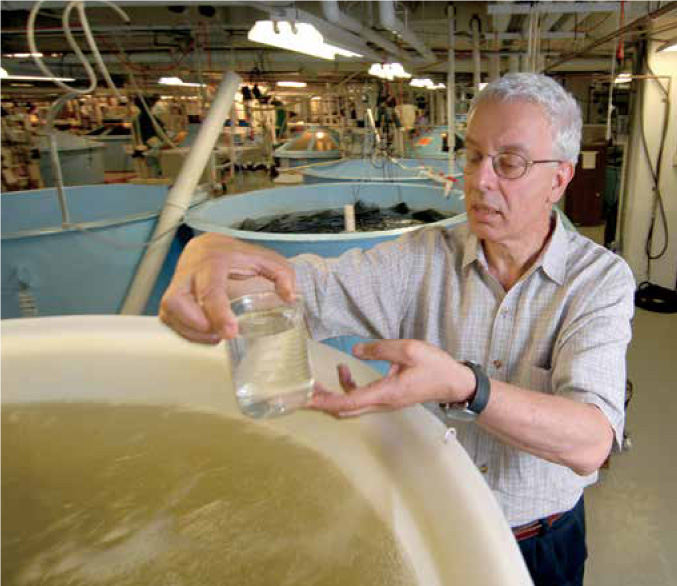14.4 Scientists study the possibility of growing marine fish indoors.
Perched on the edge of Baltimore’s Inner Harbor, the University of Maryland’s Center of Marine Biotechnology (COMB) looks like a cross between a classic ship and a modern research facility. A sleek glass façade covers one side of the building, and a giant sail covers the other. Deep in the lower decks, in the lab of COMB director and marine scientist Yonathan Zohar, land and sea get blurred further still. Pipes, computers, and narrow cylindrical filters buzz and whir above several rows of tanks, each roughly the size, shape, and light-blue shade of a small above ground swimming pool. Inside the tanks, giant fin fish—mostly sea bass, many weighing over 36 kilograms—create whirlpools as they retrace the same circumference over and over; they seem blissfully unaware of the machinations around them, or the bay outside, or the ocean beyond.
The operation, known as a recirculating aquaculture system (RAS), is Zohar’s brainchild. The fish were spawned, hatched, and raised to adulthood in the lab. If all goes to plan, they will be harvested and sold to area restaurants—as Mediterranean sea bass—and will eventually end up in the lunches and dinners of local patrons. “This is a real leap,” says Zohar. “The ability to grow these large predatory fish indoors, away from the ocean, will really change the way we see these animals and the way we think about fish as food.”
Zohar began his career in the 1970s on the banks of the Red Sea, when the environmental movement was in its infancy and global fisheries were just beginning to show signs of distress. Forward-thinking scientists had begun searching for ways to domesticate fish—just as humans had domesticated cattle, poultry, and pork—so that wild stocks might be spared as human populations swelled. Aquaculture had already been used for centuries to grow freshwater fish like tilapia. Canada, too, is trying its hand at aquaculture, which is projected to grow over time. Already, it’s become the fourth largest producer of farmed salmon. Sadly, cod aquaculture has been less successful, as they are difficult to raise and easily substituted by other forms of white-fleshed fish, creating less of a market. But most fish farms are family or village operations—just big enough to provide a few dozen people with a steady food supply. Zohar wanted a fish farm that could feed a modern city, or even a country. He also wanted one that could raise large marine species. “With marine aquaculture, we are talking about fish that one, we are running out of, and two, are the most beneficial to human health,” he says.

253

But there was a huge barrier to realizing this vision: most commercially important marine fish—like sea bream, sea bass, and tuna—would not reproduce in captivity. Some scientists had suggested recreating spawning grounds—specific areas where fish come every year to deposit their eggs and sperm—in captive breeding sites. But that seemed wildly impractical to Zohar. “Most of these fish travel hundreds to thousands of miles to reach their spawning grounds,” he says. “They move through a wide range of temperatures, water depths, and salinities, and nobody had any clue which of these variables was the key to getting them to reproduce, let alone how to recreate all of that in a finite space.” So instead he tracked several species across the ocean and measured their hormonal changes as they navigated the open waters. As it turned out, one particular hormone was produced in the wild but not in captivity. By developing a hormone supplement for the fish, Zohar and his colleagues tricked the captive fish into breeding as they would in the wild.
But just as that problem was resolved, other problems began creeping up.